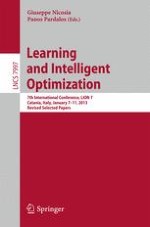2013 | Buch
Learning and Intelligent Optimization
7th International Conference, LION 7, Catania, Italy, January 7-11, 2013, Revised Selected Papers
herausgegeben von: Giuseppe Nicosia, Panos Pardalos
Verlag: Springer Berlin Heidelberg
Buchreihe : Lecture Notes in Computer Science
